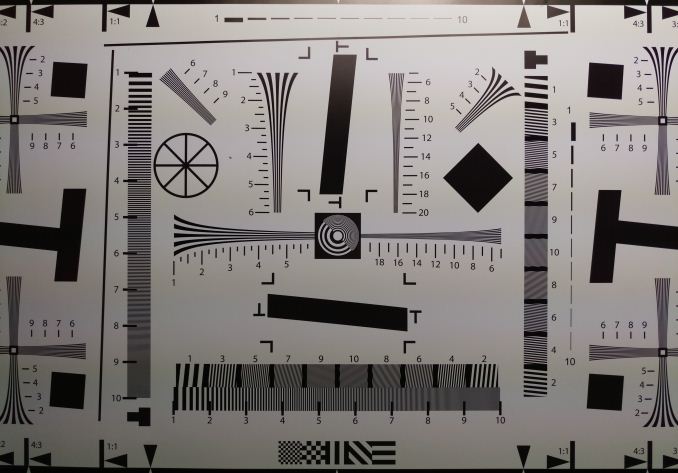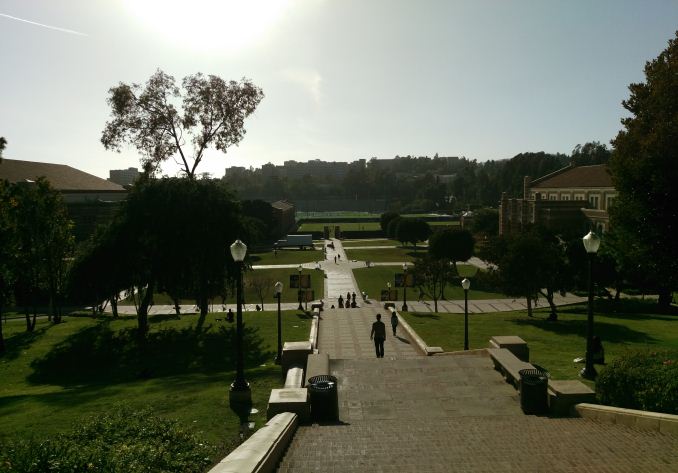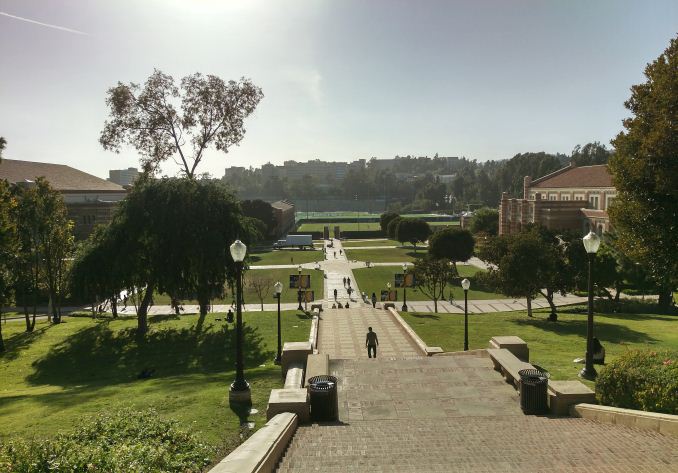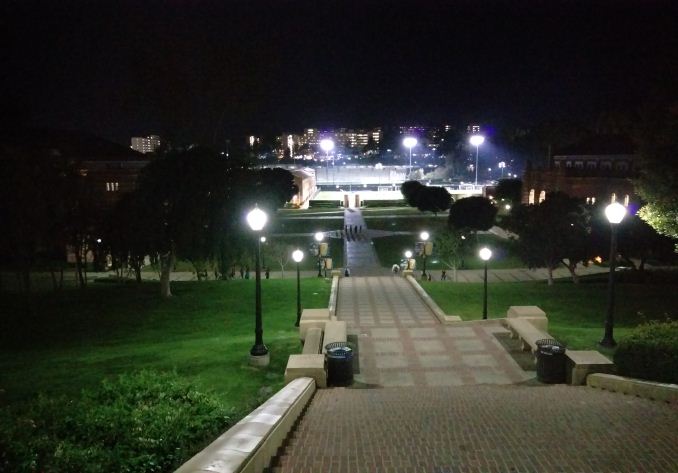The HTC One M9 Review: Part 2
by Joshua Ho on April 6, 2015 10:00 AM EST- Posted in
- Smartphones
- HTC
- Qualcomm
- Mobile
- Snapdragon 810
- One M9
Camera Performance
Now that we've finished going over the camera architecture and user experience of the One M9 we can talk about the end result, namely the quality of the still images and video that the One M9 can produce. Our first test is a basic test of spatial resolution, which uses high-contrast line pairs that make it possible to get a good idea for what the effective maximum resolution of the camera is.
In this test, we can see the benefits of the 20MP camera sensor of the One M9, spatial resolution in this test is a massive improvement over what we saw from the One M8. At the center, the resolution of the camera is sufficient to resolve up to the 20 mark. Resolution at the edges of the frame remains sufficiently high, with no obvious field curvature in this test. To get a more nuanced look of low ISO camera performance, we can look at some standard daytime shots to get a better idea of real-world camera performance.
Here we can start to see some of the real issues with the One M9's camera. It's immediately obvious that the sky here is just the wrong color. Although Los Angeles can be a smoggy place, the sky in this photo should be a stronger shade of blue, not gray with a tinge of blue. Looking at the texture of the roof, the grass throughout the photo, and the bleachers off in the distance, it's pretty obvious that HTC needs to strongly reduce the noise reduction that they're using here, as there's almost no detail in these photos. The detail is basically comparable to the iPhone 6's 8MP camera, which shouldn't be the case in these daytime conditions. The lack of shadow detail also degrades perceived quality. In general, the photo appears to be a bit underexposed as well.
With the HDR mode, all of the issues seen in auto mode are still present. However, to HTC's credit HDR mode is now usable instead of being almost useless as it was with the One M8. HTC still needs to focus on reducing halos as there seem to be issues with this on some high contrast edges/moving objects and make HDR a live preview similar to the Galaxy S5 and S6 camera, but in general this is a dramatic improvement when compared to previous devices.
In low light, the One M9 performs horribly. There's really not much else to be said because there's next to no detail in these photos. Noise reduction has smeared away what detail there was. Despite the fact that the photos have evidence of incredibly strong noise reduction, there's still a lot of noise visible in the image. Thankfully, the color noise of the image is low which makes things better, but for 1600 ISO and 1/9 second exposure time, the output is nothing to talk about.
Moving on the video quality, we can first look at 1080p30 quality. HTC uses a 20Mbps encode rate, using H.264 Baseline for video, and 192Kbps AAC for audio encoding. While the iPhone 6 can serve as a reasonable reference, there are a lot of apparent issues even if one doesn't look to the iPhone 6 for a point of comparison. In general, 1080p video doesn't seem to carry a great deal of detail with it, and it looks like there isn't any kind of video stabilization going on here. The result is that footage is extremely shaky and really kind of disappointing here.
For 1080p60 we can basically see the same story, as the One M9 still has a noticeable lack of detail and there are a lot of problems with camera shake that aren't dampened out. It almost looks like HTC doesn't have any kind of stabilization for video here, which is rather disappointing. The bitrate of 1080p60 footage is also unchanged from the 1080p30 settings, which is a bit curious.
For 720p120 slow motion, HTC does manage to capture real 720p footage instead of upsampled 480p video, and it compares favorably to the iPhone 6 but detail continues to be a problem here. The encoder settings are similar to 1080p30 with its H.264 Baseline setting, but bit rate is reduced to 12.1 Mbps.
Overall, the performance of the One M9's camera is disappointing. Overall, it's still probably better than the One M8's camera, but the execution is lacking. HTC needs to focus on improving detail by avoiding aggressive noise reduction, reduce aggressive sharpening, improve shadow detail, implement effective EIS and OIS, and work on improving auto-focus and capture latency. It's concerning that HTC still cannot come close to the competition in this area, and given that camera is a crucial aspect of any smartphone experience HTC needs to resolve all of these issues if they want to remain relevant in the smartphone market.






































127 Comments
View All Comments
phoenix_rizzen - Wednesday, April 8, 2015 - link
Once you start using double-tap-to-wake, and double-tap-status-bar-to-sleep (some launchers even let you set double-tap-on-home-to-sleep), you'll find yourself rarely using the power button for anything.However, if you use your phone a lot for music, you'll really come to love having the power button and volume controls on the back of the phone. You don't have to put your hand in your pocket with the phone to manage the media. Just slide the phone into your pocket with the screen along your leg ... and the buttons are now accessible through the outside of the pocket! So much nicer that way. Especially with the headphone jack on the bottom, which makes the buttons align correctly when the phone is in your pocket (move your finger "up" or straighten it for volume up).
The other really nice thing about the G2 is that it has a 5.2" screen size ... but the overall phone size is smaller than most phones with only 5.0" screens. They're really done a great job keeping the overall phone sizes down since the Optimus G. I have no issues keeping my G2 in my front jeans pockets, front shorts pockets, or the inside pocket of my jackets.
Compared to the last 3 HTC and Sony phones, the LG G2 can be considered a compact phone.
melgross - Monday, April 6, 2015 - link
I think a big part of the problem is that Apple surprised the industry with the A7 64 bit SoC. Everyone is trying to catch up. But it seems likely that no one was actively working on 64 bits except Apple. The new Tegra looks good, but has its own problems with thottling, etc.Qualcomm was caught with its pants down. That's for sure. The 810 seems rushed, and is far from optimized. Perhaps later in the year, new tapeouts will fix some of the problems. Samsung's SoC is a bit better, but is still behind
aenews - Tuesday, April 7, 2015 - link
Well final versions of products haven't been released for the X1. And take in mind that even though the K1 was released earlier than the Snapdragon 805, even the Snapdragon 810 doesn't come close to matching it. And the X1 is "twice" as fast potentially. Even if the final performance is reduced in mobile settings, it would still be far, far faster than anything else =). And the K1 has no issue with throttling. Nvidia wouldn't let default settings be too aggressive if it meant throttling. The Snapdragon 810 would probably perform more admirably in these new devices with the temperature throttling turned off or adjusted in terms of temperature or reduced clock speeds.sonicmerlin - Saturday, April 11, 2015 - link
I would prefer a 32 bit A8X with my iPad Air 2 so I could have the increased RAM footprint of 64 bit apps back. Qualcomm was taken surprise by the public hype of 64 bit. Even the Nexus 9 suffers a bit with 64 bit and only 2 GB of RAM.JeffFlanagan - Monday, April 6, 2015 - link
HTC has made trading my M8 in for a Samsung Galaxy S6 an easy choice. I was probably already going to do it for the VR, but it's clear that their's no benefit to sticking with HTC.melgross - Monday, April 6, 2015 - link
Well, the consensus right now is that the S6 is the best Android phone for sure, but that the Edge is gimmicky and overpriced.jabber - Monday, April 6, 2015 - link
Amazes me that in this day and age a premium smartphone can still screw up the camera. How hard can it be? Forget gimmicks just get the basics right. With so many good off the shelf options...just bizarre.J4ckb1ng - Monday, April 6, 2015 - link
But the camera is a gimmick. A phone is designed to make and receive calls. How odd nobody seems to want a phone to do the one thing it is primarily designed to do. When I read HTC was fiddling with the camera on the M9, I heaved a sigh of relief.jabber - Monday, April 6, 2015 - link
If you said that 5+ years ago I would have tended to agree but that's no longer the case. The camera for many has become more important than making calls.I bet if you asked a survey of 1000 smartphone users what was the top three reasons for having a smartphone I'd be surprised if making calls scraped in at 3.
Refuge - Monday, April 6, 2015 - link
I saw that you are on your first smartphone in another post of yours. So I understand if you haven't converted yet.But Smartphones aren't phones. I mean they are, but they aren't.
They are hubs to the world. This is a communication device, that is meant to be mobile and contain every form of communication we could ever crave.
Instagram, facebook, youtube, text messaging, instant messaging, skype, Uvuu, phone too.
I use mine mostly for internet, email, and text. But thats just the nature of my business. Phone calls come through too, but only for things that can't be said one off in a text.